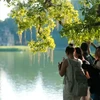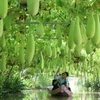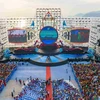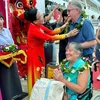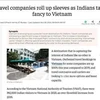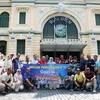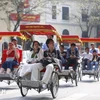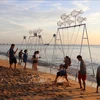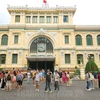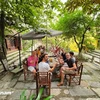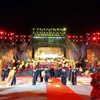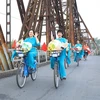 1. Hanoi authorities have allowed relic sites to welcome visitors back following the closure prompted by COVID-19. The municipal Department of Culture and Sports has asked localities to strengthen preventive measures at relic sites. Reopening has to strictly follow health guidance of relevant agencies and the city. Historical and cultural sites are asked to prepare for COVID-19 prevention and control. Visitors are encouraged to receive at least two shots of COVID-19 vaccine or test negative with the disease within 72 hours using RT-PCR method before going to the sites. At this point, however, most temples and pagodas in the capital city reported fewer numbers of visitors compared to the same period in previous years. (Photo: Minh Anh/Vietnam+)
1. Hanoi authorities have allowed relic sites to welcome visitors back following the closure prompted by COVID-19. The municipal Department of Culture and Sports has asked localities to strengthen preventive measures at relic sites. Reopening has to strictly follow health guidance of relevant agencies and the city. Historical and cultural sites are asked to prepare for COVID-19 prevention and control. Visitors are encouraged to receive at least two shots of COVID-19 vaccine or test negative with the disease within 72 hours using RT-PCR method before going to the sites. At this point, however, most temples and pagodas in the capital city reported fewer numbers of visitors compared to the same period in previous years. (Photo: Minh Anh/Vietnam+)  Historical and cultural relics in Hanoi are ready to welcome international visitors after a month of opening. However, the number of visitors has yet to increase significantly. Welcoming visitors back from February 15, monuments in the city such as Van Mieu-Quoc Tu Giam (Temple of Literature), Hoa Lo Prison or Ngoc Son Temple witnessed a lower number of visitors. Historical and cultural sites are asked to prepare for COVID-19 prevention and control. Visitors are encouraged to receive at least two shots of COVID-19 vaccine or test negative with the disease within 72 hours using RT-PCR method before going to the sites. (Photo: Minh Anh/Vietnam+)
Historical and cultural relics in Hanoi are ready to welcome international visitors after a month of opening. However, the number of visitors has yet to increase significantly. Welcoming visitors back from February 15, monuments in the city such as Van Mieu-Quoc Tu Giam (Temple of Literature), Hoa Lo Prison or Ngoc Son Temple witnessed a lower number of visitors. Historical and cultural sites are asked to prepare for COVID-19 prevention and control. Visitors are encouraged to receive at least two shots of COVID-19 vaccine or test negative with the disease within 72 hours using RT-PCR method before going to the sites. (Photo: Minh Anh/Vietnam+)  2. At the Van Mieu-Quoc Tu Giam (Temple of Literature) relic site, the number of visitors has been modest over the past time. Data provided by the management board shows that the relic welcomes about 100-150 visitors on weekdays, and about 200-300 visitors at weekends, equivalent to only 10 percent compare to before the pandemic. According to Director of Centre for Scientific and Cultural Activities of the Temple of Literature Le Xuan Kieu, the complicated developments of the pandemic has resulted in the situation. Normally, the Temple of Literature welcomes about 60 percent foreign visitors. This is the reason why the relic is looking forward to welcoming this group of visitors back, according to Kieu. (Photo: Minh Anh/Vietnam+)
2. At the Van Mieu-Quoc Tu Giam (Temple of Literature) relic site, the number of visitors has been modest over the past time. Data provided by the management board shows that the relic welcomes about 100-150 visitors on weekdays, and about 200-300 visitors at weekends, equivalent to only 10 percent compare to before the pandemic. According to Director of Centre for Scientific and Cultural Activities of the Temple of Literature Le Xuan Kieu, the complicated developments of the pandemic has resulted in the situation. Normally, the Temple of Literature welcomes about 60 percent foreign visitors. This is the reason why the relic is looking forward to welcoming this group of visitors back, according to Kieu. (Photo: Minh Anh/Vietnam+)  Historical and cultural sites are asked to prepare for COVID-19 prevention and control. Visitors are encouraged to receive at least two shots of COVID-19 vaccine or test negative with the disease within 72 hours using RT-PCR method before going to the sites. Visitors are required to comply with regulations related to pandemic prevention and control, such as checking their body temperatures, wearing face masks, and washing hands. According to Director of Centre for Scientific and Cultural Activities of the Temple of Literature Le Xuan Kieu, a body temperature meter and hand sanitiser will be installed for visitors. The centre will also promote the typical tourism products to attract more visitors to the relic site. (Photo: Minh Anh/Vietnam+)
Historical and cultural sites are asked to prepare for COVID-19 prevention and control. Visitors are encouraged to receive at least two shots of COVID-19 vaccine or test negative with the disease within 72 hours using RT-PCR method before going to the sites. Visitors are required to comply with regulations related to pandemic prevention and control, such as checking their body temperatures, wearing face masks, and washing hands. According to Director of Centre for Scientific and Cultural Activities of the Temple of Literature Le Xuan Kieu, a body temperature meter and hand sanitiser will be installed for visitors. The centre will also promote the typical tourism products to attract more visitors to the relic site. (Photo: Minh Anh/Vietnam+)  Van Mieu-Quoc Tu Giam (Temple of Literature), Ngoc Son Temple, Hoa Lo Prison are among Hanoi's tourist attractions reopened to welcome tourists back. They are deploying safety precautions such as body temperature checks and hand sanitisers. Historical and cultural sites are asked to prepare for COVID-19 prevention and control. All visitors are asked to wear face masks. Data provided by the management board shows that the relic welcomes about 100-150 visitors on weekdays, and about 200-300 visitors at weekends, equivalent to only 10 percent compared to before the pandemic. Hanoi's tourist hotspots were closed for more than a month recently due to the COVID-19 pandemic. (Photo: Minh Anh/Vietnam+)
Van Mieu-Quoc Tu Giam (Temple of Literature), Ngoc Son Temple, Hoa Lo Prison are among Hanoi's tourist attractions reopened to welcome tourists back. They are deploying safety precautions such as body temperature checks and hand sanitisers. Historical and cultural sites are asked to prepare for COVID-19 prevention and control. All visitors are asked to wear face masks. Data provided by the management board shows that the relic welcomes about 100-150 visitors on weekdays, and about 200-300 visitors at weekends, equivalent to only 10 percent compared to before the pandemic. Hanoi's tourist hotspots were closed for more than a month recently due to the COVID-19 pandemic. (Photo: Minh Anh/Vietnam+)  Meanwhile, visitors to Hoa Lo Prison are mainly young people who want to come to visit and do research. According to Tran Trung Bac at the Managing Board of the Hoa Lo Prison relic site, this place attracts an average of 300 to 500 visitors at weekends and about 200 guests on weekdays. These numbers are quite a bit lower when compared to those numbers before the pandemic, Bac said. At the peak period, it can welcome more than 1,000 guests per day. In order to be ready to welcome foreign tourists safely, this relic site has undergone a lot of preparations toward COVID-19 prevention and control. (Photo: Minh Anh/Vietnam+)
Meanwhile, visitors to Hoa Lo Prison are mainly young people who want to come to visit and do research. According to Tran Trung Bac at the Managing Board of the Hoa Lo Prison relic site, this place attracts an average of 300 to 500 visitors at weekends and about 200 guests on weekdays. These numbers are quite a bit lower when compared to those numbers before the pandemic, Bac said. At the peak period, it can welcome more than 1,000 guests per day. In order to be ready to welcome foreign tourists safely, this relic site has undergone a lot of preparations toward COVID-19 prevention and control. (Photo: Minh Anh/Vietnam+)  Visitors to the Hoa Lo Prison Relic Site in Hanoi are invited to experience an automatic audio guide with 35 interesting stories about people, events and objects at the prison. They can also join various activities including an exchange with historical witnesses, a contest to help them learn more about the prison’s history, and an incense offering at the prison’s monument. The site’s management board has adopted necessary measures on pandemic prevention and control to ensure the safety of visitors and avoid spreading of SARSCoV2, including cleaning and disinfecting the site, and measuring body temperatures and providing visitors with hand sanitisers. (Photo: Minh Anh/Vietnam+)
Visitors to the Hoa Lo Prison Relic Site in Hanoi are invited to experience an automatic audio guide with 35 interesting stories about people, events and objects at the prison. They can also join various activities including an exchange with historical witnesses, a contest to help them learn more about the prison’s history, and an incense offering at the prison’s monument. The site’s management board has adopted necessary measures on pandemic prevention and control to ensure the safety of visitors and avoid spreading of SARSCoV2, including cleaning and disinfecting the site, and measuring body temperatures and providing visitors with hand sanitisers. (Photo: Minh Anh/Vietnam+)  Hoa Lo Prison is a historical attraction located on Hoa Lo Street, Hoan Kiem District, in Hanoi. It was formerly known in French as Maison Centrale (meaning central prison) and in Vietnamese as Hanoi Prison. This prison was built in 1896 by the French in this area which used to belong to the outskirts of the city. In its day, it was the central prison to confine mainly political prisoners and patriots against the colonial government, from both Central and Northern Vietnam. Hoa Lo Prison Relic Site in Hanoi is offering gifts to the first 500 tourists upon reopening on May 14, after being closed under social distancing rules for COVID-19 prevention and control. (Photo: Minh Anh/Vietnam+)
Hoa Lo Prison is a historical attraction located on Hoa Lo Street, Hoan Kiem District, in Hanoi. It was formerly known in French as Maison Centrale (meaning central prison) and in Vietnamese as Hanoi Prison. This prison was built in 1896 by the French in this area which used to belong to the outskirts of the city. In its day, it was the central prison to confine mainly political prisoners and patriots against the colonial government, from both Central and Northern Vietnam. Hoa Lo Prison Relic Site in Hanoi is offering gifts to the first 500 tourists upon reopening on May 14, after being closed under social distancing rules for COVID-19 prevention and control. (Photo: Minh Anh/Vietnam+)  During the French colonial period, Hoa Lo prison was built with a structure consisting of 4-meter high and 0.5-meter thick stone walls that were reinforced with electric wires. The total area of the former prison was more than 12,000 square meters. However, today only 2,434 square meters is retained and preserved to become a relic area for sightseeing. Notoriously called “a hell on earth" and the most feared prison in Southeast Asia during its operation, Hoa Lo Prison was where many generations of Vietnamese soldiers and revolutionary activists were imprisoned. With its historical role, Hoa Lo Prison is an intriguing destination to visit in Hanoi, attracting many domestic and foreign tourists. (Photo: Minh Anh/Vietnam+)
During the French colonial period, Hoa Lo prison was built with a structure consisting of 4-meter high and 0.5-meter thick stone walls that were reinforced with electric wires. The total area of the former prison was more than 12,000 square meters. However, today only 2,434 square meters is retained and preserved to become a relic area for sightseeing. Notoriously called “a hell on earth" and the most feared prison in Southeast Asia during its operation, Hoa Lo Prison was where many generations of Vietnamese soldiers and revolutionary activists were imprisoned. With its historical role, Hoa Lo Prison is an intriguing destination to visit in Hanoi, attracting many domestic and foreign tourists. (Photo: Minh Anh/Vietnam+)  Hoa Lo Prison is a historical attraction located on Hoa Lo Street in Hanoi. Visitors to the site are invited to experience an automatic audio guide with 35 interesting stories about people, events and objects at the prison. They can also join various activities including an exchange with historical witnesses, a contest to help them learn more about the prison’s history, and incense offering at the prison’s monument. An exhibition, entitled “The Desire of Freedom”, will open at the prison on the occasion, with works on display highlighting the determination of revolutionary soldiers to escape from the French colonial prison in order to continue to their struggle for freedom. (Photo: Minh Anh/Vietnam+)
Hoa Lo Prison is a historical attraction located on Hoa Lo Street in Hanoi. Visitors to the site are invited to experience an automatic audio guide with 35 interesting stories about people, events and objects at the prison. They can also join various activities including an exchange with historical witnesses, a contest to help them learn more about the prison’s history, and incense offering at the prison’s monument. An exhibition, entitled “The Desire of Freedom”, will open at the prison on the occasion, with works on display highlighting the determination of revolutionary soldiers to escape from the French colonial prison in order to continue to their struggle for freedom. (Photo: Minh Anh/Vietnam+)  The capital city’s key attractions such as the Temple of Literature, Phu Khanh Pagoda, Tao Sach Pagoda, Hoe Nhai Pagoda, Thang Long Imperial Citadel, Hoa Lo prison, and Ngoc Son Temple have settled to the new normal, after they were temporarily closed to contain the spread of the SARSCoV2 virus. The attractions require visitors to wear face masks, use hand sanitisers, and keep a safe distance during their stay. Chairing a meeting between the city’s Steering Board for COVID-19 Prevention and Control and districts on March 8, Vice Chairman of the municipal People’s Committee Chu Xuan Dung stressed that localities need to maintain prevention measures to prevent the next wave of COVID-19. (Photo: Minh Anh/Vietnam+)
The capital city’s key attractions such as the Temple of Literature, Phu Khanh Pagoda, Tao Sach Pagoda, Hoe Nhai Pagoda, Thang Long Imperial Citadel, Hoa Lo prison, and Ngoc Son Temple have settled to the new normal, after they were temporarily closed to contain the spread of the SARSCoV2 virus. The attractions require visitors to wear face masks, use hand sanitisers, and keep a safe distance during their stay. Chairing a meeting between the city’s Steering Board for COVID-19 Prevention and Control and districts on March 8, Vice Chairman of the municipal People’s Committee Chu Xuan Dung stressed that localities need to maintain prevention measures to prevent the next wave of COVID-19. (Photo: Minh Anh/Vietnam+)  Ngoc Son temple is a popular destination for international visitors and Vietnamese people who come to pray for good fortune. Ngoc Son Temple relic was built in the Ly Dynasty (1009–1225) in the Northeast of Hoan Kiem Lake. At the gate of the temple is the Pen tower engraved with three Han-Nom characters. These are "Ta Thanh Thien" which means "Writing on the clear blue sky”. To get to Jade Island and Ngoc Son Temple visitors have to go through a bridge named The Huc which means “Light of Dawn” because it faces East where the sun rises. The bridge stands out with a vermilion color, crossing the emerald Hoan Kiem Lake. (Photo: Minh Anh/Vietnam+)
Ngoc Son temple is a popular destination for international visitors and Vietnamese people who come to pray for good fortune. Ngoc Son Temple relic was built in the Ly Dynasty (1009–1225) in the Northeast of Hoan Kiem Lake. At the gate of the temple is the Pen tower engraved with three Han-Nom characters. These are "Ta Thanh Thien" which means "Writing on the clear blue sky”. To get to Jade Island and Ngoc Son Temple visitors have to go through a bridge named The Huc which means “Light of Dawn” because it faces East where the sun rises. The bridge stands out with a vermilion color, crossing the emerald Hoan Kiem Lake. (Photo: Minh Anh/Vietnam+)  Ngoc Son Temple was originally called Ngoc Son Pagoda. Later, the pagoda was changed to Temple. The relic site worships Van Xuong De Quan (Wenchang Dijun), who is a Taoist deity of dignity and good fortune and general Tran Hung Dao (1228-1300). Undergoing several demolitions in history, in 1865 the temple was repaired by scholar Nguyen Van Sieu. He also built the The Huc bridge spanning from the shore of the lake to the temple. Ngoc Son Temple is a popular destination for international visitors and Vietnamese people who come to pray for good fortune or simply to have a new point of view to admire the beauty of Hoan Kiem Lake. (Photo: Minh Anh/Vietnam+)
Ngoc Son Temple was originally called Ngoc Son Pagoda. Later, the pagoda was changed to Temple. The relic site worships Van Xuong De Quan (Wenchang Dijun), who is a Taoist deity of dignity and good fortune and general Tran Hung Dao (1228-1300). Undergoing several demolitions in history, in 1865 the temple was repaired by scholar Nguyen Van Sieu. He also built the The Huc bridge spanning from the shore of the lake to the temple. Ngoc Son Temple is a popular destination for international visitors and Vietnamese people who come to pray for good fortune or simply to have a new point of view to admire the beauty of Hoan Kiem Lake. (Photo: Minh Anh/Vietnam+)  Ngoc Son Temple was built according to the Chinese character of “three” with three main sections including the external section for kowtowing; the central section for worshiping Van Xuong De Quan; and the internal section for worshiping Tran Hung Dao. There are also many paralleled sentences, paranormal and sacred decorations displayed at the temple. Each of these depictions contains deep and thoughtful meaning as part of the temple. It’s two-storey roof was built in a square shape with eight supporting columns beneath. Ngoc Son Temple is a popular destination for international visitors and Vietnamese people who come to pray for good fortune or simply to have a new point of view to admire the beauty of Hoan Kiem Lake. (Photo: Minh Anh/Vietnam+)
Ngoc Son Temple was built according to the Chinese character of “three” with three main sections including the external section for kowtowing; the central section for worshiping Van Xuong De Quan; and the internal section for worshiping Tran Hung Dao. There are also many paralleled sentences, paranormal and sacred decorations displayed at the temple. Each of these depictions contains deep and thoughtful meaning as part of the temple. It’s two-storey roof was built in a square shape with eight supporting columns beneath. Ngoc Son Temple is a popular destination for international visitors and Vietnamese people who come to pray for good fortune or simply to have a new point of view to admire the beauty of Hoan Kiem Lake. (Photo: Minh Anh/Vietnam+)  Hanoi authorities have allowed relic sites to welcome visitors back following a long closure prompted by COVID-19. The capital city’s relic sites have settled in to a new normal after they were temporarily closed to contain the spread of the SARSCoV2 virus. The attractions require visitors to wear face masks, use hand sanitisers, and keep a safe distance during their stay. Chairing a meeting between the city’s Steering Board for COVID-19 Prevention and Control and districts on March 8, Vice Chairman of the municipal People’s Committee Chu Xuan Dung stressed that localities need to maintain prevention measures, so as to prevent the next wave of COVID-19. (Photo: Minh Anh/Vietnam+)
Hanoi authorities have allowed relic sites to welcome visitors back following a long closure prompted by COVID-19. The capital city’s relic sites have settled in to a new normal after they were temporarily closed to contain the spread of the SARSCoV2 virus. The attractions require visitors to wear face masks, use hand sanitisers, and keep a safe distance during their stay. Chairing a meeting between the city’s Steering Board for COVID-19 Prevention and Control and districts on March 8, Vice Chairman of the municipal People’s Committee Chu Xuan Dung stressed that localities need to maintain prevention measures, so as to prevent the next wave of COVID-19. (Photo: Minh Anh/Vietnam+) VNA
